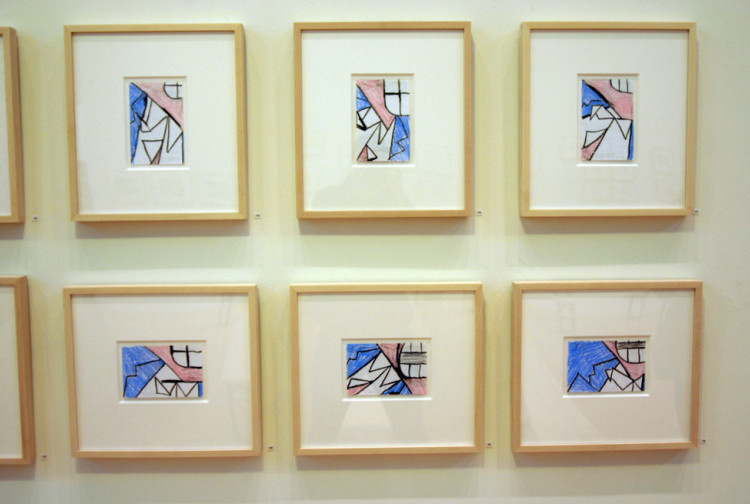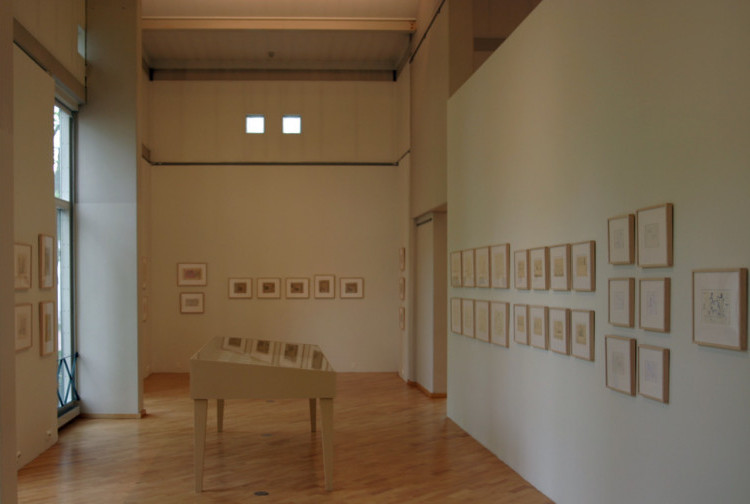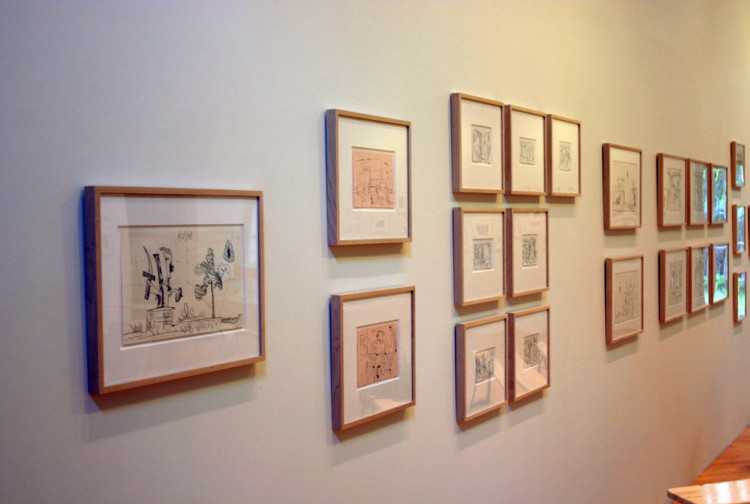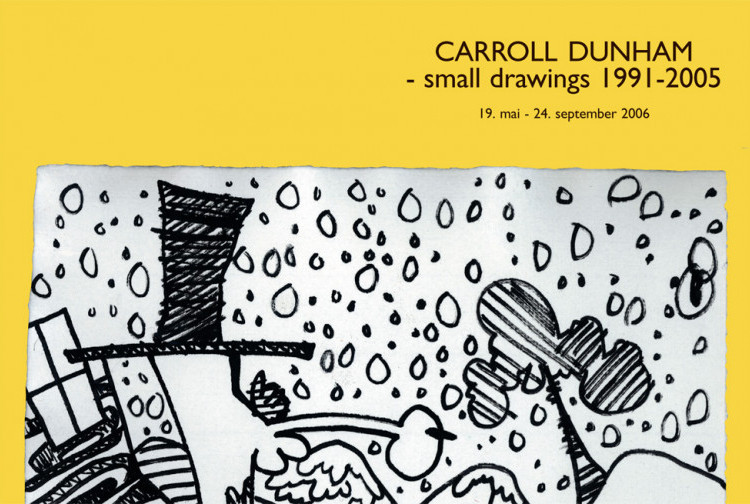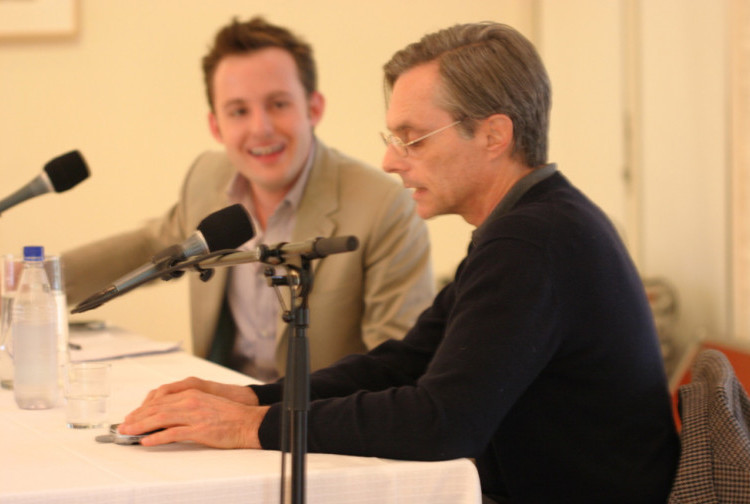Carroll Dunham - retrospective drawing exhibition
The artist Carroll Dunham (b. 1949) shows drawings in this exhibition. The selection is based on a review of his entire archive of drawings in small format. These drawings have a special place in his art - which also deals with painting, graphics and sculpture - since it is in them that the development of ideas, themes and design language is easiest to follow.
The drawings show some of the most typical of Dunham's art, namely that he deals with related themes and forms, but that in the various media he examines the material and stylistic possibilities of each medium. He has an extraordinary sensitivity to visual and tactile differences. This is seen in the drawings in the choice of different types of paper and drawing tools, and not least the choice of stylistic tools. It alternates between thin pencil strokes, ballpoint pen, charcoal, soft and powerful pencil, grease pen and felt-tip pen. An interplay is created between different paper qualities and the chosen cartoon character that is seen in the figures themselves. The artist seeks to achieve maximum energetic, visual dialogue with the graphic features and qualities in the paper field the scenes unfold.
The exhibition has been created in a collaboration where Åsmund Thorkildsen at Drammens Museum and Carroll Dunham through three long periods of work in Dunham's drawing archive in New York City made a selection that should be as representative as possible for these 15 years of work with drawings. The exhibition is arranged chronologically since it thus shows how the themes have developed. The development of the themes at Dunham is connected with how the forms also develop. There is no question of any modernist, formal "progress" in these works. Dunham is skeptical of the whole idea of progress, so what is happening in his world of images is a development that explores the culture in which he lives and its civilizational prehistory.
The first thing the viewer notices in Dunham's drawings are the furious characters or agents acting. These come from strange, hybrid forms that seem to emerge from a globe "primordial soup". From the very beginning, with the drawings from 1991, an aggressive, challenging and a bit gloomy feel is felt. What at first seems like indeterminate figures, as it is unclear whether conscious beings or not eventually develop into beings with clear human features (they almost always lack eyes) such as noses, hair, arms, genitals and eventually, clothing . The characters gradually gain an increasingly concentrated field of action and what in some images seems like unmotivated anger or directionless aggression, in many of the images is directed towards another figure.
For the exhibition, Drammens Museum publishes a book, where the exhibition's curator, Åsmund Thorkildsen has interpreted the development in the images in terms of an evolutionary theory, and where the field of action towards the end seems more and more localizable, namely to the American scene, agricultural areas and small towns. that the virgin field to the west was subject to the plow and arms of the settlers. On the one hand, these drawings show conflicts of interest and contradictions between man and man and between a male and female principle. Eventually you can even say between a man and a woman. That these drawings are made exactly in our time, is presented in the book as symptomatic of the conflicts that exist in American society today - and also in other Western societies. The western countries have developed many aspects of society in a civilized, liberated and positive direction, with great individual freedom and well-distributed prosperity very many enjoy. But the humanistic hope that knowledge, welfare growth and reason would create a society of peaceful and polite fellow human beings has not always materialized. Much of the reason probably lies in the fact that basic drives and unresolved tensions still lurk beneath the well-kept surface and are still a challenge for the humanistic and democratic project. Simply put, Carroll Dunham's drawings from the last 15 years are a contemporary reflection on the prehistory that has created exactly the complicated stage of civilization we are now in. Unlike much of the canned nature of modern and post-modern art, Dunham's paintings are filled with symbols and signs that we can understand, since they are part of the cultural commonwealth of Western society. A close study of the exhibition's over 250 drawings will therefore be able to provide many tips on what is going on, and it is a rare opportunity for the audience to go on a journey of discovery in the natural and cultural historical drama that takes place.
Carroll Dunham is from Hartford Connecticut and currently lives in New York City. He graduated from Trinity College, Hartford Connecticut (1972). In 2004 he received the Showhegan Medal for Distinction in Painting. He has been represented by some of the world's best galleries (Sonnabend Gallery, Metro Pictures and now, Gladstone Gallery in New York). He has held over 20 solo exhibitions in both the United States and Europe since his debut in 1981 and has participated in a number of significant group exhibitions since 1978. In 2002, a retrospective exhibition of his paintings was held at the New Museum of Contemporary Art in New York. The exhibition in Drammens Museum is the first retrospective exhibition of his small drawings.
Carroll Dunham is i.a. purchased by the Museum of Modern Art in New York, the Whitney Museum of Armerican Art in New York, the Walker Art Center in Minneapolis, the Brooklyn Museum of Art in New York, the Art Institute of Chicago, the Albertina Museum in Vienna and the Tate Gallery in London.
Carroll Dunham teaches at the Master's Program in Painting at Yale University in New Haven, Connecticut and writes about art for Artforum, New York.
Åsmund Thorkildsen
Museum director

